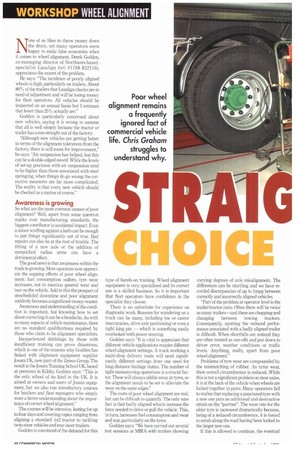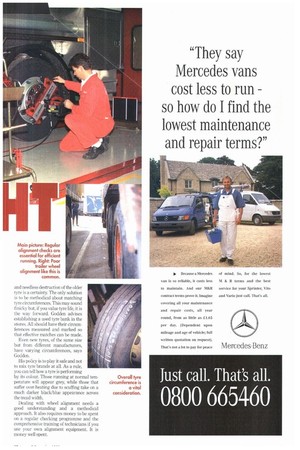WORKSHOP WHEEL ALIGNMENT
Page 50

Page 51

If you've noticed an error in this article please click here to report it so we can fix it.
Poor wheel alignment remains a frequently ignored fact of commercial vehicle life. Chris Graham struggles to understand why.
None of us likes to throw money down the drain, yet many operators seem happy to make false economies when it comes to wheel alignment. Derek Godden, ex-managing director of Northants-based specialist Lasalign (tel: 01788 822116), appreciates the extent of the problem.
He says: "The incidence of poorly aligned wheels is high, particularly on trailers. About 80% of the trailers that Lasalign checks are in need of adjustment and will be losing money for their operators. All vehicles should be inspected on an annual basis but I estimate that fewer than 25% actually are."
Godden is particularly concerned about new vehicles, saying it is wrong to assume that all is well simply because the tractor or trailer has come straight out of the factory "Although new vehicles are getting better in terms of the alignment tolerances from the factory, there is still room for improvement," he says. "Air suspension has helped, but this can be a double-edged sword. While the levels of set-up precision with air suspension tend to be higher than those associated with steel springing, when things do go wrong the corrective measures are far more complicated. The reality is that every new vehicle should be checked as a matter of course."
Awareness is growing
So what are the most common causes of poor alignment? Well, apart from some question marks over manufacturing standards, the biggest contributor is accidental impact. Even a minor scuffing against a kerb can be enough to put things significantly out of true. Bad repairs can also be at the root of trouble. The fitting of a new axle or the addition of unmatched radius arms can have a detrimental effect.
The good news is that awareness within the trade is growing. More operators now appreciate the sapping effects of poor wheel alignment: fuel consumption suffers, tyre wear increases, not to mention general wear and tear on the vehicle. Add to this the prospect of unscheduled downtime and poor alignment suddenly becomes a significant money-waster.
Awareness and understanding of the condition is important, but knowing how to set about correcting it can be a headache. As with so many aspects of vehicle maintenance, there are no standard qualifications required by those who claim to be alignment specialists.
Inexperienced dabblings by those with insufficient training can prove disastrous, which is one of the reasons why Godden has linked with alignment equipment supplier Josam UK, now part of the Zeteco Group. The result is the Josam Training School UK, based at premises in Kilsby. Godden says: "This is the only school of its kind in the UK. It is aimed at owners and users of Josam equipment, but we also run introductory courses for hauliers and fleet managers who simply want a better understanding about the importance of correct wheel alignment."
The courses will be intensive, lasting for up to four days and covering topics ranging from aligning a standard 4x2 tractor to tackling twin-steer vehicles and rear-steer trailers.
Godden is convinced of the demand for this
type of hands-on training. Wheel alignment equipment is very specialised and its correct use is a skilled business. So it is important that fleet operators have confidence in the specialist they ch(xise.
There is no substitute for experience on diagnostic work. Reasons for wandering on a truck can be many, including toe or castor inaccuracies, drive axle positioning or even a tight king pin — which is something easily overlooked with power steering.
Godden says: "It is vital to appreciate that different vehicle applications require different wheel alignment settings. A truck working a multi-drop delivery route will need significantly different settings from one used for long-distance haulage duties. The number of tight manoeuvring operations is a crucial factor. These will always nibble away at tyres, so the alignment needs to be set to alleviate the wear on the outer edges."
The costs of poor wheel alignment are real, but can be difficult to quantify. The only sure fact is that badly aligned wheels increase the force needed to drive or pull the vehicle. This, in turn, increases fuel consumption and wear and tear, particularly on the tyres.
Godden says: "We have carried out several test sessions at MIRA with trailers showing varying degrees of axle misalignment. The differences can be startling and we have recorded discrepancies of up to lmpg between correctly and incorrectly aligned vehicles.
"Part of the problem at operator level is the trailer/tractor ratio. Often there will be twice as many trailers—and these are chopping and changing between towing tractors. Consequently, spotting the reduced performance associated with a badly aligned trailer is difficult When shortfalls are noticed they are often treated as one-offs and put down to driver error, weather conditions or traffic levels. Anything, really, apart from poor wheel alignment."
Problems of tyre wear are compounded by the mismatching of rubber. As tyres wear, their overall circumference is reduced. While this is not a significant problem on steer axles, it is at the back of the vehicle when wheels are locked together in pairs. Many operators fail to realise that replacing a punctured tyre with a new one puts an additional and destructive strain on the "partner". The wear rate for the older tyre is increased dramatically because, being of a reduced circumference, it is forced to scrub along the road having been locked to the larger new one.
If this is allowed to continue, the eventual and needless destruction of the older tyre is a certainty. The only solution is to be methodical about matching tyre circumferences. This may sound finicky but, if you value tyre life, it is the way forward. Godden advises establishing a used tyre bank in the stores. All should have their circumferences measured and marked so that effective matches can he made.
Even new tyres, of the same size but from different manufacturers, have varying circumferences, says Godden.
His policy is to play it safe and not to mix tyre brands at all. As a rule, YOU can tell how a tyre is performing by its colour. Those running at normal temperature will appear grey, while those that suffer over-heating due to scuffing take on a much darker black/blue appearance across the tread width.
Dealing with wheel alignment needs a good understanding and a methodical approach. It also requires money to be spent on a regular checking programme and the comprehensive training of technicians if you use your own alignment equipment. It is money well spent.
















































































































